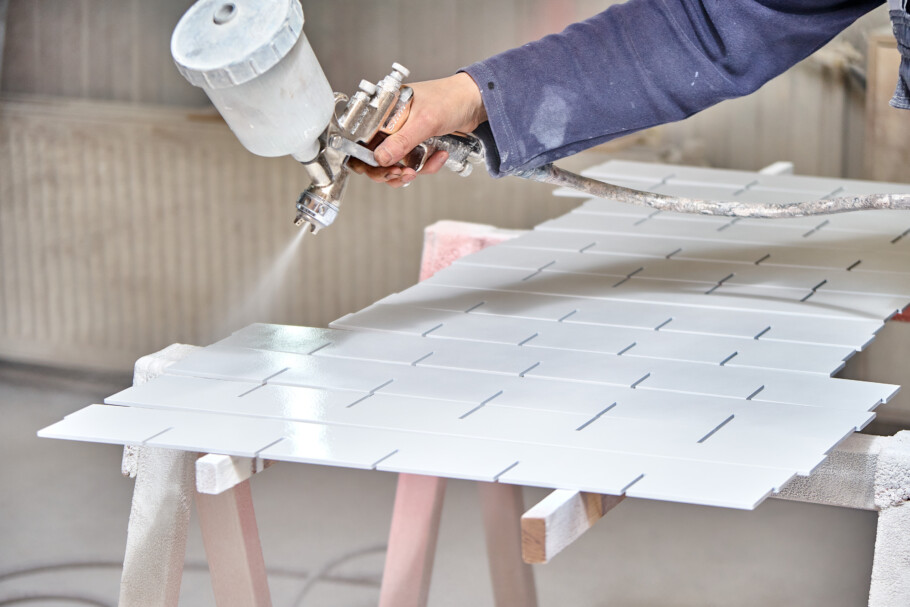Firstly, we can briefly breakdown the chemical components that make up the finishes most used: The primary component that determines the properties of the coating is the resin, which could be epoxy, acrylic, or polyurethane for example. The second main component is then the solvent, which is what disperses the paint into a liquid. This is what can either be chemically based or water based.
Traditionally solvent-borne coatings have been preferred as they ensured a hard and durable finish that resists scratches and abrasions. They were also being considered easier to apply as they often require fewer coats and can be more forgiving of contaminated surfaces. Solvent-based paints have also been proven to be more efficient in freezing temperatures and other climatic conditions. However, high levels of VOCs (Volatile Organise Compounds) can be found in solvent-based paint. VOCs are used as a mechanism for transferring the paint to a surface in an even and flowing manner. Nevertheless, these chemicals are proven to have a harmful impact to not only the user but the environment as well.
There are a multitude of technologies and technical terms associated with water-based paints but put simply it is a paint manufactured with water. It is made up of around 70% water, 20% solids and only 10% solvent. Although we have identified advantages of using solvent-based paints, water-based finishes are now increasingly becoming the go to solution. There are numerous benefits to using water-based paints of which we can pinpoint below.
In contrast to solvent-bearing, water-based paints produce far fewer VOCs which in result means they do not produce gases that can cause further damage to the ozone making it a more sustainable and environmentally friendly solution. This also results in fewer impacts on health such as headaches and trouble breathing making it much safer for the user. Water-borne solutions aren’t flammable, meaning there is less need for extra equipment and fewer regulations on transportation. This also aligns with government regulation which has become increasingly stricter on manufacturers to reduce VOC emissions, so water-based paints can be a solution in preparation for further legislation.

Although water-based paints drying time can be considerably shorter in comparison to solvent based paint they are much more sensitive to the climate. In winter months, for example, you may have some trouble with dry spray and bad flow. And in summer months you might experience some issue with drying and sagging. To effectively dry water based finishes the environment needs to be controlled for temperature and humidity. Although there are lots of variations on the air flows in spray booths the basic flow holds true. Humid air inside the booth is removed for dry air outside the booth to enable further evaporation of the finish. The air that is sent out is generally vented to the atmosphere, so air from the atmosphere needs to be brought into the booth as replacement air and brought up to the right temperature. The energy required for this temperature lift can be significant. We will go over the basics of performing this calculation in a later “industry insight”. In brief, a spray booth needing 50,000m3 of replacement air per hour will require 250Kw to maintain the required temperature. At current Gas prices this could cost you £20,000 annually, however, if Gas prices continue to rise as expected this could end up costing you upwards of £60,000 a year. Depending on your fuel this is where we find water-based paints to be environmentally flawed.
With one of the key reasons for more companies switching to water-borne solutions being the rising importance of sustainability. It can then prove counterproductive dependant on the fuel you use for your heating system to facilitate efficient drying. Gas heating systems such as direct gas air heaters are commonly used and can prove an effective heat source. However, gas systems produce copious amounts of damaging carbon emissions, and with climate targets increasing it could become obsolete in a matter of years. The recent Gas crisis also means that your gas bill could be significantly higher with gas prices rising by 200% since August (Read More here). It is a similar story with Oil heating systems with oil boilers producing twice as much carbon as Gas and oil prices being at their highest since 2014. Although electrical heating systems are thought to be greener than gas and oil, they too can prove costly, and many factories do not have the electrical distribution capacity required.
We do think that water-based paints are here to stay and the environmental benefits in the long term are there. However, the transition to water-based finishes will have an increase in energy usage to avoid a drying bottleneck in cold weather. An industrial wood-waste boiler could prove to be the solution to get this extra energy through sustainable, carbon neutral means. An industrial biomass boiler provided by us at Ranheat can replace the need of gas and other fuels by utilising your wood waste already present at your factory. Not only would this insulate your business from volatile energy costs which we are currently experiencing but also offer a new way for you to reduce your carbon footprint. Feel free to get in touch to learn what an Industrial wood waste boiler could do for you. (Contact Us).
MATT LOCAL